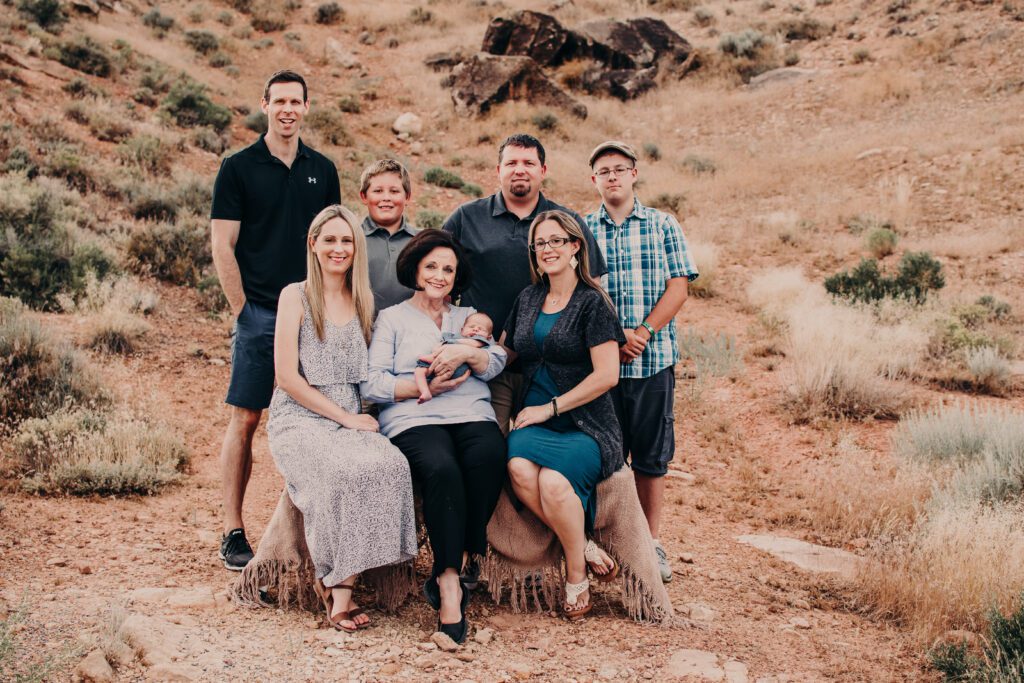
It took six years, 700 shots, and a selfless surrogate to bring our beautiful son, Spencer John Wilson, into the world.
It was a long journey and like most things worth fighting for, a hard one.
Injecting myself with artificial hormones 700 times was actually the “easy” part.
Injecting myself with artificial hormones 700 times was actually the “easy” part.
The pain, frustration, and side effects of the injections didn’t come close to the heartache and unrelenting disappointment that weighed on me throughout my infertility journey.
By the end we had sixteen failed IVF transfers, four failed IUI transfers, seven egg retrievals, three miscarriages, and two international surrogacy experiences.
But we now have our beautiful son, and I would do it all again.
My husband, Ryan, and I had married in 2011 and soon after, decided to try for a family.
Being in our early thirties then, we naively thought it would be easy. But after about a year, we knew something wasn’t right.
And so, our infertility journey began. After failed Clomid and IUI cycles, we started IVF.
For me, IVF was a roller coaster of emotions. Some weeks I felt despair, anger, and guilt – Why can’t I do the one thing women are supposed to be able to do? Other weeks, I was optimistic and full of adrenalin.
Looking back, we played our first IVF appointment all wrong. We sat there politely nodding, occasionally asking a question and agreeing with all the answers.
If I could do that over, I would go in with a list of questions and I wouldn’t accept platitudes like: “It’s not a matter of ‘if’ but ‘when.’”
After a few failed transfers and an ectopic pregnancy, my transfers kept getting cancelled because of my “thin endometrium lining.”
My uterine lining was always about 6mm at transfer, the minimum required for transfer in Australia, where we live. I didn’t think much of it. Then after a few cancelled cycles, I researched it. Wow–did I find out a lot!
Specifically, the lining is crucial to becoming pregnant and sustaining a pregnancy. As the wallpaper of the uterus, it becomes thicker with pregnancy so it’s ready to receive an embryo and support the placenta.
An optimal lining at transfer is 10-to-12mm. On our cancelled cycles, my lining measured in the high 4mm. On the ones that went ahead, it was 5.5-6mm. But at that thickness, it’s extremely difficult to conceive.
We changed to an implantation specialist and he hit us with the hard truth: Thin linings are rare, usually genetic, and difficult to fix.
One question raced through my mind: Why have we not been told this sooner? I felt a sense of betrayal by our previous specialist. I was angry about the time, money, and mental energy we had already wasted.
Our new doctor then told us that surrogacy would be our best chance of success.
At work that week I felt deflated, but told no one. Meanwhile, a colleague had a sports injury and received lots of support. Fair enough. But it highlighted to me the silent stigma and suffering of infertility.
When people have an illness or injury, they often share the news and rely on friends and family for support. The World Health Organization defines infertility as a reproductive disease—a disease. Yet many people hide it.
I was regrettably too worried too often about people’s opinions. Our good friends and family were always sensitive. But once people outside of our close circle knew, there were many hurtful comments.
People would say: “Have you tried relaxing?” or “It will happen when you stop trying.” I know most people were trying to help but I regret not speaking up sooner about the medical facts.
Not ready to close the door on being pregnant myself, we pushed ahead with a transfer with a lining of 6mm and became pregnant.
The high was enormous. But the next day, dread set in. My lining was just thick enough, but it wasn’t ideal.
At our first scan at 7.5 weeks, we had the devastating news that our baby’s heartbeat was too slow. Two days later at our follow-up scan, she had passed.
We were absolutely crushed.
Shortly after my D&C procedure, our specialist called with the biopsy results. The baby had been genetically normal. The baby was a girl. I wish I hadn’t found out the gender. It made the loss more real, more heartbreaking.
The unfortunate takeaway, though, was that this loss confirmed that the issue was me.
The unfortunate takeaway, though, was that this loss confirmed that the issue was me.
With each collection, our specialist would retrieve an above-average number of eggs for my age and when tested for chromosome abnormalities, most tested normal.
The problem wasn’t the embryos. It was the carrier—me.
It was time to explore surrogacy. With surrogacy a difficult process in Australia, we started surrogacy in Canada with Julie, a selfless woman who felt compelled to help us. It was a long flight (18 hours) for the transfer but it was such an important milestone.
What happened next still haunts me.
The day of the transfer, our specialist told us the devastating news that the container of embryos we had transported was empty.
With a pounding heart and almost breathless, I kept asking him: “What do you mean by empty? Who can we call?”
He looked at me sadly, spoke to me in a gentle voice. There was no one to call.
The embryos were gone, and any chance of having a baby with them was gone, too.
We knew that there’s a standard protocol for transporting embryos, so what happened to us was extremely rare. Our lawyers and fertility clinics in Melbourne and Toronto had never heard of this ever happening. We kept going.
Back in Australia, we were able to collect more embryos, and had three transfers in Canada. All failed. With heavy hearts, we knew we had to move on.
It was at this time I saw a psychologist who used cognitive behavioral therapy (CBT). She recommended that instead of fixating on what I didn’t have, to focus on what I did. And to try, as hard as it was, to not let the infertility consume me. Yes, it was a significant part of my life, but I shouldn’t let it be my identity. I shouldn’t let it have that power over me. There is no question that adopting the CBT techniques helped to reshape my mindset and build my resilience.
It was at this time I saw a psychologist who used cognitive behavioral therapy (CBT). She recommended that instead of fixating on what I didn’t have, to focus on what I did. And to try, as hard as it was, to not let the infertility consume me.
Ryan and I also had some mandatory counselling as a couple. There were times when I had to drag Ryan along to a session but once he was there, he found that talking confidentially to an independent person was invaluable.
In one of our sessions, the counsellor suggested date days.” She said: “You’re going through an immensely stressful time. As a couple, it’s imperative that you make time for each other, and try to have some fun in the process.”
I’ll admit that she had scared me with her pointed use of the word “imperative,” so it wasn’t long before I set up a calendar of dates. Sometimes it was as simple as a walk along the beach or going to the movies. Other times, when we really needed an escape from everything, we would go away for the weekend or take a holiday.
Reflecting on it, she was right. It was an intense time and having quality time with each other was “imperative.” We had arguments along the way of course, and some ridiculous fights, but for the most part we were a team and always on the same page.
We pursued surrogacy next in the United States, our last hurrah.
We had an instant bond with our beautiful U.S. surrogate, Leigha, and her husband, Josh.
I will always be in awe of surrogates. How someone who doesn’t know you, hears your story, and feels compelled to help you.
Our first transfer failed. But our U.S. specialist in Utah had some good insights and recommended an Endometrial Receptivity Array (ERA) for our surrogate. An ERA is a genetic test where they take a small sample of a woman’s endometrial lining to identify the best day and time to transfer an embryo.
There are three potential outcomes with the ERA test: pre-receptive, receptive, and post receptive. For most women, the optimum time to transfer an embryo is during the receptive phase, five days after ovulation. To our surprise, we had been transferring too early, during the pre-receptive phase. For our best chances of success, we would need to transfer twelve hours later.
Our second transfer worked.
We heard the heartbeat at our eight-week scan, and we all felt at peace.
We skipped the Skype call for our 10-week scan as it was at 3am. I awoke early but there were no messages. I had an awful feeling something was wrong.
I then saw a message on Ryan’s computer screen: “I’m so sorry but we’ve lost the baby.”
We were all heart broken.
I wanted to scream and cry and give up. With every other set back, I was determined to fight. But this time the fight had vanished. I struggled to accept we were here again.
But we had some good embryos left and our surrogate Leigha was determined to keep going. Ryan encouraged me, repeating everything the doctor had said about how the miscarriage was rare (subchronic hematoma) and unlikely to happen again. We tried one last time.
Nine months later, our beautiful son Spencer was born.

Infertility can be brutal, raw, and is often a lonely road. It’s frequently misunderstood. But for anyone struggling with infertility, an important lesson is to learn about your body and figure out your issues, your questions, your tolerance for the hard road.
While there are many similar infertility stories, each person makes her own decisions. Be an advocate for yourself and figure out what you or you and your partner need to continue building your family.
Contributor
Kirsten McLennan
Kirsten McLennan lives in Melbourne, Australia with her husband, Ryan, and their beautiful son, Spencer. She's a mum, communications practitioner, writer, and advocate for infertility awareness. You can follow her story @straight.up.infertility.

Listen to stories, share your own, and get feedback from the community.


















